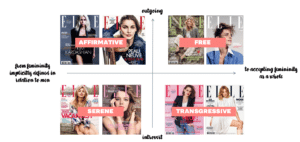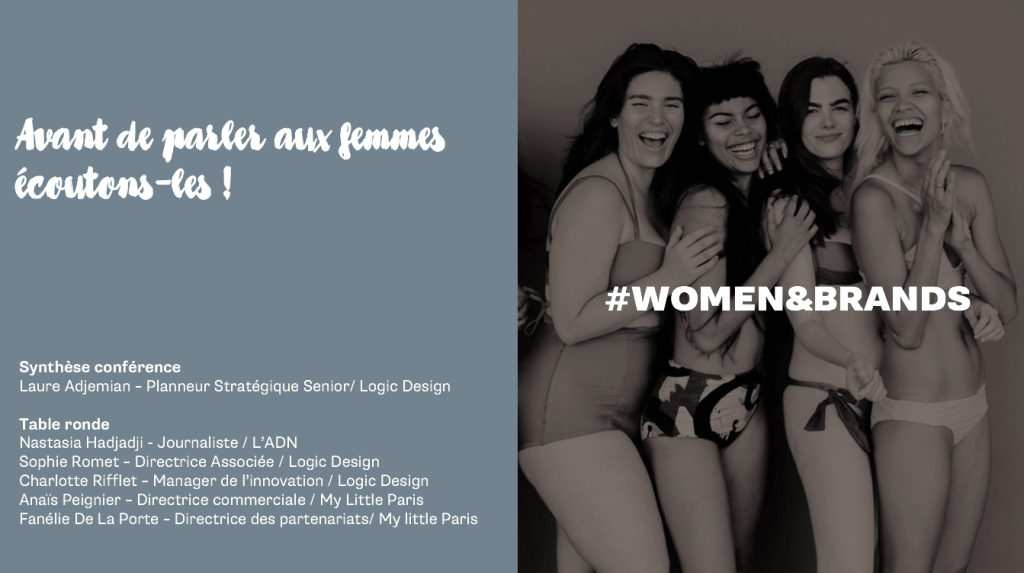Our thinking on the representation of women in brands discourse was motivated by an observation. In a changing political and social context as gender-equality initiatives are multiplying, as women’s voice is being heard with movements such as #MeToo and #6novembre15h35, brands do not seem to shift the lines much. Brands discourse is still tainted with representations that are still somehow stereotypical, a mock rhetoric of what would be a discourse “made for women”.
How can brands support these changes? How can they renew their discourse while remaining consistent with their purpose, without giving in to opportunism?
Women have long been implicitly defined by their relation to men; they were stuck in an overly narrow definition, like in too tight jeans. This could not last anymore. The switch operates thanks to the spreading of a more realistic, more truthful vision of women, a more human vision in short. Finally we face up to the truth: women do not wake up fresh and vibrant, household chores are not magically done, women do have their period every month and the colour is not blue, women do age, women do come, etc. Women have their own self expression not in relation to someone else but for their own sake: they reappropriate words used about men, they too can be bold, brave and surpass themselves. They accept their femininity as a positive element and “desobjectify” their bodies to take care of them and not deny them. Breaking free from rules that used to imprison them in a function (seduction, woman-mother-wife, beauty requirements, etc.), they become more independent thus more powerful.
From a stance of claiming equality in which women were always implicitly defined in relation to men and had to free themselves from their chains (like Julia Roberts in the first version of the commercial for the Lancôme perfume “La Vie est Belle”), we are gradually moving towards a stance in which they accept their femininity in all its dimensions. In other words, we have moved on from an excluding culture of idealized women’s lives to a transparent exposure: the “no-filter” trend appears, be it in matters of public speaking, of make-up, of accepting imperfection, ageing or failure. However, we are only at the beginning of the process and a lot of women are still “negotiating” this behavioural and psychological shift. It is neither a goal nor an ideal, not all women will adopt these behaviours. Nevertheless, it is a deep-rooted trend that will influence them and allows brands to reassess the direction they take and the role they play regarding women.
We based our work on semiotic analyses and qualitative interviews and produced a mapping of these new representations of femininity through 4 archetypes: two of them are more “classical” (on the left-hand side), women are implicitly represented in relation to men; the other two are more “modern” (on the right-hand side) and go towards accepting femininity in all its aspects. The pointer is set on the capacity to move away for classical models with the added data of “introvert” or “outgoing”. It goes without saying that these are trends, brands can address “hybrid” women, the mapping is only here to point out and embody these archetypes and give brands landmarks.

4 expression universes for contemporary women:
- “affirmative”
She expresses her difference through an identification to men in a power relationship led by her signs of femininity.
- “serene”
She expresses her difference in a form of complementarity to men: gentleness as opposed to strength.
- “transgressive”
Her femininity is used to defy current conventions and established rules, sometimes her feminine dimension is stronger, sometimes it is her masculine dimension and the other is internalized.
- “free”
She finds her balance in her ability to make an asset of her femininity without the need to identify or comply with “masculine” rules, nor oppose them.
The model that strikes us as the most remarkable and change inducing is the one on the top right-hand of the mapping, that of the women who have freed themselves from the diktat of the masculine vision – or simply the vision of the others -, who are at ease with their femininity – also in ageing, putting on weight or breast-feeding. For us, this model of femininity can be embodied by Mélanie Thierry or Emma Watson. Its specificity is that it is multifaceted: the women there can be good friends or femmes fatales, often committed and fostering a relationship to men based on equality. They are at ease with their femininity in all its dimensions while defending their rights.
How can we know who we address and how to reach these women?
All women do not necessarily identify with that new model but brands need to take these changes into account to bypass obsolete marketing archetypes. Rather than just having in mind the archetypal woman, they need to be more human-centric to understand the expectations, the behaviours, the habits and the beliefs of their audiences.
To address women, brands have a lot of work ahead.
First of all, they need to work on their mission for nowadays, beyond product or service, brands must offer a vision of the world and even act on it.
Secondly, they need to work on their offer taking into account how women live, their habits, perceptions and preferences.
That is why, only an approach centered on women as individuals (and not stereotypes) and a collaborative co-design of new models will make it possible to represent them in a different way.
5 keys to accompany change towards new codes for brands
1/ Start thinking about a “feminine consumer experience”
Design a “woman-centric” consumer experience: a product that meets the constraints women face, a service that fits with what is specific to women, a way to take into account the feminine factor.
Maison Plisson offers free delivery to pregnant women, Heist has based the design of a new kind of tights on the observation of how difficult it is for real women to put on shaping tights, Chez Simone is much more than a gym…
2/ Be inclusive
Brands must take into consideration how diverse women are, how diverse beauty can be, all ages, all body shapes… The model of the ambassador is being shattered.
Ysé presents their bras on different models that look more like real women, Fenty Beauty offers foundation shades that suit the palest or darkest skin tones, Good American offers jeans from sizes XXS to XXXXL…
3/ Put a stop to an oppressive image of femininity
Well-being is gradually replacing looks in contemporary women’s minds. Shaming discourses have a lesser impact. Acts prevail over looks. Therefore brands must encourage action, will-power and challenge.
Weight Watchers has figured that, renaming to WW for “Wellness Works” to design a new strategic positioning and a new offer that puts forward a vision of slimness: a search for well-being.
4/ Have a brand purpose in line with women’s lives
As Simon Sinek puts it: “start with the why”, which means design the brand’s purpose and reflect it on the whole brand experience, from the offer to the production processes, from communications and advertising to the employees’ experience…
Convenient does not mean ugly, that is what Kali has understood creating organic hygiene products presented as desirable objects, or else Flamingo with their refined shaving kits.
5/ Commit
Brands must be able to support women in everything they want to achieve. They do not stand up for a “cause”, but rather offer a structuring vision of the world.
Hence, Contrex has launched their entrepreneurial program “Les Elles” and Goldie Box has reinvented toys “for girls”.
Experts’ opinion co-written by Laure Adjemian, Sophie Romet & Juliette Raynaud
Find all our experts opinions here !
Keywords : branding agency, women & brands, conference

